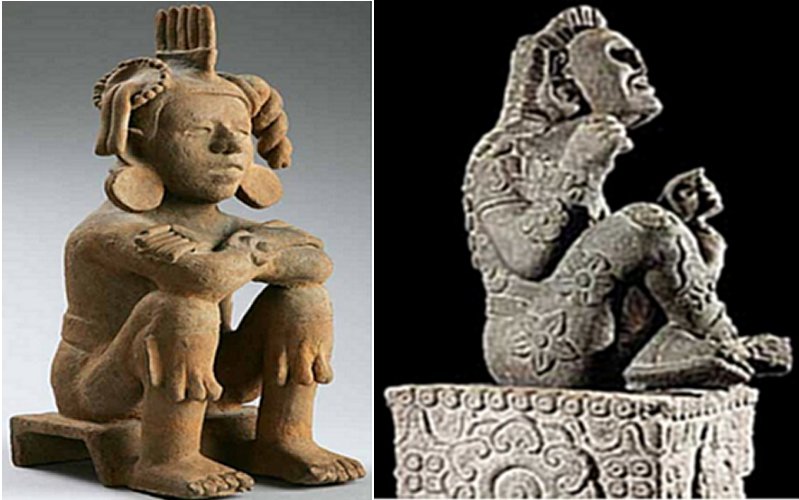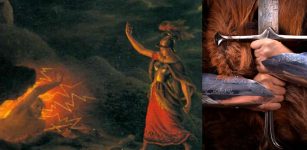Xochipilli: Aztec God Of Love, Music, Song And Ecstatic Mushroom Trance
A. Sutherland - AncientPages.com - Among the main sculptures that have come to us from the ancient Nahuatl culture is Xochipilli, the 'Lord of Flowers'.
Scholars believe that the figure of this deity was carved about one generation before the arrival of Spaniards.

Xochipilli - Aztec God of Flowers, Dance, Song, Love – statue from Art. Museo Nacional de Antropologia,Mexico City.
Xochipilli’s name contains the Nahuatl words xochitl ("flower") and pilli (either "prince" or "child"), and therefore means "flower prince". He is also referred to as Macuilxochitl, which means "five flowers".
Discovery of a remarkable statue
In the mid-1800s, an impressive statue of Xochipilli, carved in stone, was unearthed on the western slopes of the volcanoes Popocatepetl and Iztaccihuatl near Tlalmanalco, south-eastern Mexico. The statue is now housed in the Museum of Anthropology and History of Mexico City.
The statue of Xochipilli is 79 cm high and carved in stone. It represents an extraordinary work of art and depicts Xochipilli, the “god of flowers” who is related to a number of pleasurable activities such as dance, song, music, love, feasting, painting, writing, and song.
The deity is sitting on a temple-like granite base, about 43 cm high and 60 cm per side. His body – in an ecstatic visionary trance - is adorned with sacred flowers (psychotropic plants) and other garments that richly decorate a beautifully carved, basalt temple platform.

Left: Xochipilli, Aztec terracotta, Lombards Museum; Right: Xochipilli covered with “flowers”. Museo Nacional de Antropologia Mexico
It is widely known that the Aztecs possessed advanced knowledge of hallucinogenic plants, which are known to have been used in sacred rituals of this culture.
Sacred mushrooms and flower plants but not quite ordinary ones
In his book “The Wondrous Mushroom - Mycolatry in Mesoamerica”, Robert Gordon Wasson (1898 –1986), an American author and ethnomycologist, describes Xochipilli, the deity of ecstatic mushroom trance. The deity is totally absorbed in temicxoch, 'the flowery dream' state that follows the ingestion of hallucinogenic plants.
He "wears a mask with hollowed-out eyes, his face lifted upward with a fixed gaze. This is a depiction of a man in ecstatic trance. His feet are crossed, toes curled, hands held lightly above the knees at the level of the heart. All around the base of the figurine as well as on his body are images of various flowers, including the hallucinogenic morning glory (ololiuhqui), and mushrooms in profile…"
The “flowers”, however, are not the ordinary ones but rather botanically unspecified plants, frequently mentioned in Nahuatl poetry and as Wasson explains for the Nahua poets and singers, "flowers" and "flowering" or "dream flowers" referred to the visionary experience induced by teonanacátl mushrooms.
Wasson, with the advice of Richard Evans Schultes, director of the Harvard botanical museum, identified the “flowers” that Xochipilli has on his body. Surprisingly, they are not any ordinary plants but species that contain psychoactive substances; they are so-called “dream flowers” or Temicxoch. The divine Xochipilli, writes Gordon Wasson, is absorbed in Temicxoch; he is in ecstasy.
"The flowers took them to another world . . . a world that they called their Tlalocan, a world of strange and wondrous beauty, where they reveled in sensations beyond imagining," writes Wasson.
As we mentioned earlier, Xochipilli symbolizes song and dance, games, love and flowers, maize and beauty. He was also highly respected as the protector of mushrooms, especially earlier mentioned “teonanacátl mushrooms”. This unusual Psilocybin sponge only grows in a small region of Mexico at 3300 - 3700 meters above sea level on the volcano Popocatepetl (where the statue of Xochipilli was found).
As one of the fertility gods, he was a deity linked with agriculture and the cultivation of staple crops such as maize. Many archeologists believe he was first worshipped during the years of the Teotihuacan civilization but was later adopted by the Aztecs.
This kind of mushroom is also known as the “sacred mushroom of visions” and its name teonanacátl means "divine flesh" (or "divine flesh"). It certainly gives us an idea of how important and respected this mushroom was by the Aztecs.
Xochipilli was particularly worshiped at Xochimilco, built in the 16th century by the Spanish on the ruins of Tenochtitlan, the old Aztec capital, Mexico City. The most common offering to this god was pulque, the alcoholic beverage, and corn.
Written by – A. Sutherland AncientPages.com Staff Writer
Copyright © AncientPages.com All rights reserved. This material may not be published, broadcast, rewritten or redistributed in whole or part without the express written permission of AncientPages.com
Expand for referencesMore From Ancient Pages
-
 Mystery Of The Vanished Settlers Of Greenland – What Happened To The Lost Viking Colonists?
Books | Jul 22, 2023
Mystery Of The Vanished Settlers Of Greenland – What Happened To The Lost Viking Colonists?
Books | Jul 22, 2023 -
 Carved Stone Depicting Mystery Horseman Unearthed At Roman Vindolanda, Hadrian’s Wall
Archaeology | Jul 1, 2021
Carved Stone Depicting Mystery Horseman Unearthed At Roman Vindolanda, Hadrian’s Wall
Archaeology | Jul 1, 2021 -
 Why Is Africa Called Africa?
Ancient History Facts | Dec 1, 2020
Why Is Africa Called Africa?
Ancient History Facts | Dec 1, 2020 -
 Streets Of Ancient Rome Were Very Dangerous
Ancient History Facts | Feb 29, 2016
Streets Of Ancient Rome Were Very Dangerous
Ancient History Facts | Feb 29, 2016 -
 Incamisana Water Temple At Ollantaytambo, Peru: Marvelous Engineering Masterpiece Of Inca
Ancient Technology | Jul 19, 2019
Incamisana Water Temple At Ollantaytambo, Peru: Marvelous Engineering Masterpiece Of Inca
Ancient Technology | Jul 19, 2019 -
 Shieldmaiden Hervör’s Dangerous Quest For The Cursed Tyrfing Sword
Featured Stories | Apr 20, 2023
Shieldmaiden Hervör’s Dangerous Quest For The Cursed Tyrfing Sword
Featured Stories | Apr 20, 2023 -
 On This Day In History: Christiaan Huygens Discovers Saturn’s Largest Moon Titan – On Mar 25, 1655
News | Mar 25, 2017
On This Day In History: Christiaan Huygens Discovers Saturn’s Largest Moon Titan – On Mar 25, 1655
News | Mar 25, 2017 -
 Giants Roamed The Earth Millions Of Years Ago
Featured Stories | Sep 30, 2015
Giants Roamed The Earth Millions Of Years Ago
Featured Stories | Sep 30, 2015 -
 Gaocheng: China’s Oldest Observatory And Large Gnomon Installation Of The Ancients
Ancient Technology | Nov 5, 2016
Gaocheng: China’s Oldest Observatory And Large Gnomon Installation Of The Ancients
Ancient Technology | Nov 5, 2016 -
 2,000-Year-Old Fountain In Kibyra, The City Of Gladiators Flows Again
Archaeology | Jan 3, 2023
2,000-Year-Old Fountain In Kibyra, The City Of Gladiators Flows Again
Archaeology | Jan 3, 2023 -
 Perperikon, Tomb Of Orpheus And A Small Baffling Stone – Unraveling A Puzzling Connection That May Solve A Mythological Riddle
Featured Stories | Feb 5, 2019
Perperikon, Tomb Of Orpheus And A Small Baffling Stone – Unraveling A Puzzling Connection That May Solve A Mythological Riddle
Featured Stories | Feb 5, 2019 -
 On This Day In History: Brazil Was Officially Discovered – On Jan 26, 1500
News | Jan 26, 2017
On This Day In History: Brazil Was Officially Discovered – On Jan 26, 1500
News | Jan 26, 2017 -
 On This Day In History: The King James Bible Is Published For The First Time In London – On May 2, 1611
News | May 2, 2016
On This Day In History: The King James Bible Is Published For The First Time In London – On May 2, 1611
News | May 2, 2016 -
 Traces Of An Unknown Ancient Race Of Winged Beings And Other Mysterious Creatures Discovered In Japan
Civilizations | Nov 30, 2018
Traces Of An Unknown Ancient Race Of Winged Beings And Other Mysterious Creatures Discovered In Japan
Civilizations | Nov 30, 2018 -
 Hidden Connection Between The Zodiac, Ancient Egypt, Freemasonry And Christianity
Egyptian Mythology | Aug 14, 2018
Hidden Connection Between The Zodiac, Ancient Egypt, Freemasonry And Christianity
Egyptian Mythology | Aug 14, 2018 -
 Early Christian Necropolis Unearthed In Sant’Appianu Cathedral In Sagone, Corsica
Archaeology | Aug 3, 2020
Early Christian Necropolis Unearthed In Sant’Appianu Cathedral In Sagone, Corsica
Archaeology | Aug 3, 2020 -
 Sinister Manchac Swamp And The Chilling Curse Of Julia Brown
Featured Stories | Aug 25, 2021
Sinister Manchac Swamp And The Chilling Curse Of Julia Brown
Featured Stories | Aug 25, 2021 -
 Incredible 5,000-Year-Old New-York-Like Metropolis Discovered In Israel
Archaeology | Oct 9, 2019
Incredible 5,000-Year-Old New-York-Like Metropolis Discovered In Israel
Archaeology | Oct 9, 2019 -
 Never-Before-Seen 5,000-Year-Old Mysterious Monument On Isle Of Arran Discovered By LIDAR
Archaeology | Jan 27, 2021
Never-Before-Seen 5,000-Year-Old Mysterious Monument On Isle Of Arran Discovered By LIDAR
Archaeology | Jan 27, 2021 -
 Huehueteotl: Old Aztec God Of Fire, Time And Aging – Ceremony Of The New Fire
Aztec Mythology | Jan 31, 2019
Huehueteotl: Old Aztec God Of Fire, Time And Aging – Ceremony Of The New Fire
Aztec Mythology | Jan 31, 2019
